Part 1 – Defining your project and Obtaining a Quote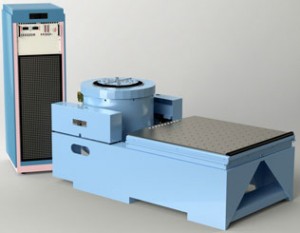
Vibration testing is a very specialized field, not very well understood by many. There are different types of vibration and there are an enormous number of vibration test specifications. Vibration testing equipment is very expensive to purchase forcing many companies to hire a vibration test lab to fulfill their vibration testing requirements. So what should you expect when Choosing A Vibration Test Lab?
You contact a lab to obtain a quote for vibration testing. The lab replies with many questions. You ask yourself, why does the lab ask so many questions just to prepare a quote? The answer is that details matter and can significantly affect the vibration test time and cost. This article is written from a vibration test lab’s point of view to help explain what information is needed to perform a successful vibration test.
Before contacting the lab, it might help to ask yourself, what is the purpose of your test? Do you need to comply with customer qualification requirements, improve your product reliability, estimate life expectancy, perform package testing, etc.? It is more effective to contact the lab after your goals are clear. It is also helpful if you can prepare a list of requirements or a statement of work or a test plan. The following are questions that a vibration test lab may ask you:
- What are the vibration test specifications?
- What is the size and weight of the product or Device Under Test (DUT), what does it look like and how many samples need to be tested?
- How will the DUT be mounted?
- Does the DUT need to be powered and monitored during the test?
- Do you need response accelerometers on the DUT?
- Are combined environments (such as temperature) and vibration required?
- Are any other unique requirements needed for the vibration test?
- What are the vibration test specifications?
There are many different vibration test specifications and test parameters that need to be defined. A few common test standards are: MIL-STD-810, MIL-STD-883, MIL-STD 167, RTCA DO-160, IEC 60068-2-64, and IEC 60068-2-6. However there are many more. The types of vibration can be random, sinusoidal (sine), sine dwell, sine on random, random on random, sine on random on random. The most common types of vibration testing services conducted by vibration test labs are sinusoidal and random. A decision will have to be made as to what type of vibration is needed and if a test specification applies. Some other test parameters that need to be defined are: acceleration or G level, frequency range, how many axes to be tested, duration per axis, sinusoidal sweep rate and number of sweeps for sine testing, random vibration PSD profile or sine vibration curve.
Many times all of the test parameters above are well defined in a test specification such as MIL-STD-810. However sometimes they are not and then you will need to provide these details to the test lab. The reason is that the details do matter and can significantly affect the test time and cost. For instance a sine sweep from 10 to 2,000 Hz at a rate of 1 octave per minute takes approximately 7.5 minutes. Performing the same sweep at a rate of 60 Hz/minute will take approximately 33 minutes. So if you need to perform 10 sweeps per axis x 3 axes, the time to complete each test will be approximately 225 minutes (3.75 hours) at a rate of 1 octave/minute vs. 990 minutes (16.5 hours) at a rate of 60 Hz/minute. Obviously a test that takes 16.5 hours to complete will cost more than one that takes only 3.75 hours.
Test requirements such as G level and random vibration PSD profile greatly affect the overall difficulty of the test. Testing at high G levels for larger, heavier products may be beyond the capabilities of some vibration test equipment. The frequency range of the test will affect the design of the vibration test fixtures.
- What is the size and weight of the product or Device Under Test (DUT), what does it look like and how many samples need to be tested?
The lab is going to ask you to provide the dimensions of the DUT and the mounting foot print. This information is required to assess vibration test fixtures and also to determine if the DUT will fit on the vibration shaker table. A drawing or sketch or picture with some overall dimensions is very helpful. Ideally the DUT should be mounted to a rigid vibration table or fixture. It is not a good idea for the product to hang over the sides of the table because that could affect its vibration response. The size and weight will also affect how many products can fit on the table simultaneously or if multiple groups need to be tested.
That leads into the question of how much does the DUT weigh? This is important because it may be easier for a vibration shaker to test a 200 pound product at 1 G than a 10 pound product at 20 G’s, (neglecting handling!!). Vibration shakers are rated for maximum force. The maximum force is determined from the formula
Force = Mass (or Weight) x Acceleration
The units for Mass are usually pounds or kilograms and Acceleration units are usually G’s or m/s2. Someone inexperienced with vibration testing might think that the same amount of force is required to test a 200 pound DUT at 1G and 10 pound DUT at 20G because the forces are equal using F=MA. It is important to note that the Mass is not only from the DUT’s but is also from the moving masses of the shaker and fixtures per the formula below:
MASS or Weight = weight of shaker armature + shaker table (slip table or head expander or cube or angle fixtures etc.) + DUT fixture + DUT’s + weight of any other adapter fixtures or significant added moving weight.
For example, let’s say the 200 and 10 pound products will use the same test fixtures and will be used on the same vibration shaker. Using the assumed weights in the table below, the total moving weight is 425 pounds for the 200 pound product and 235 pounds for the 10 pound product.

Don’t stress too much. You will only need to provide the weights of components that you are supplying such as the product to be tested, the DUT fixture weight if you are supplying this fixture, and any other significant moving weights that you are supplying such as heavy cables. The test lab will calculate the required shaker force.The total force required for the shaker is 425 pounds for the 200 pound product and 4,700 pounds for the 10 pound product. The required shaker force is more than 10 times greater for a product weighing 10 times less!! The 4,700 pounds of force required for the 10 pound product may overload some small to medium shakers.
Let’s briefly explain the parts involved. The vibration shaker armature is part of the electrodynamic shaker. Typically a magnesium head expander is bolted to the armature when testing in a vertical configuration, Figure 1. A magnesium slip table is bolted to the armature when testing in horizontal configurations, Figure 2. (Note, we will refer to the head expander or slip table as a vibration table.) These tables have a generic hole pattern. Usually an adapter plate is used to adapt the mounting pattern of the product to the magnesium shaker tables.
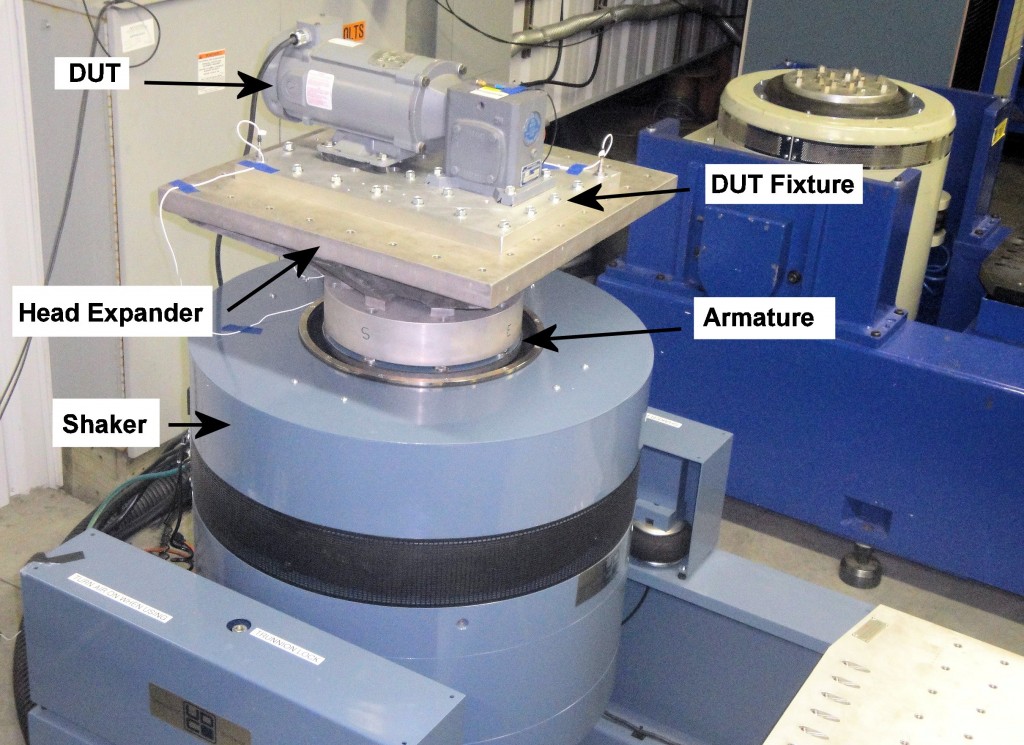
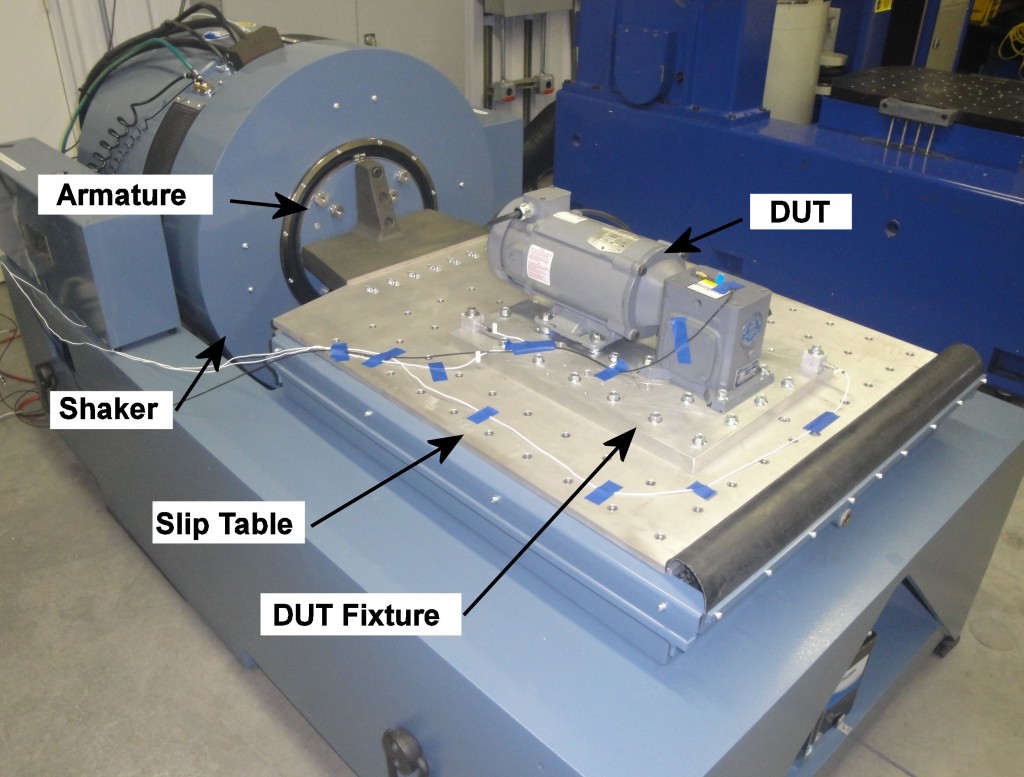
- How will the DUT be mounted?
The mounting hole pattern of your product will probably not match the hole pattern of the vibration test lab’s tables. So an adapter plate or DUT fixture will be required as seen in Figures 1 and 2. The DUT fixture will need to be bolted to the test lab’s vibration table. Then the product will be mounted to the DUT fixture. Test labs will not drill holes in their vibration tables because they are expensive specialized fixtures usually made with magnesium. The DUT fixture is typically an aluminum plate with two sets of hole patterns. One pattern matches the vibration table while the other pattern matches the product mounting. To reduce cost and lead-time, DES has generic aluminum adapter plates available and will add holes to fit your product. Bars and threaded rods can be used to attach products to the vibration shaker for products that do not have mounting holes such as a cell phone. So the DUT fixture is a cost that will have to be accounted for by you or the test lab. This cost is usually non-recurring.
- Does the DUT need to be powered and monitored during the test?
If the DUT needs to be powered and monitored during the test, then clearly this will require support equipment. This can be a simple or very complicated task. One complicated setup for a past test took DES months of planning. It required 3 phase electric, cooling water flowing through the product, and many measurements to be made during the vibration test.
Power can be simply provided from 120 alternating current (AC) single phase wall outlets or it can require complex high voltage 3 phase power from the facility or power supplies. Sometimes AC power requires special frequencies such as 400 Hz for some military equipment. This is provided from special AC power supplies. Direct Current (DC) power can be provided from DC power supplies or batteries.
Another important consideration will be if the DUT needs to be electrically loaded during the test. This can be resistive loading from components such as heaters. The loading can be inductive from AC motors. DES has previously built a 6 foot tall test rack of resistors to draw a high load through a product. On another test, DES had large blowers on the floor to load an air conditioning unit for a rail car.
Monitoring can be from simple visual observations or it can require complex measurements. Typical monitoring equipment are data loggers, digital multi-meters and oscilloscopes. Different kinds of sensors can be used to provide monitoring data such as thermocouples or speed sensors.
The big question is who will provide this equipment. Test labs can typically provide most needed equipment at added cost. Nobody has every piece of test equipment, but there are test equipment rental companies that provide calibrated test and measurement equipment.
- Do you need response accelerometers on the DUT?
Some test specifications such as RTCA DO-160 require a resonance scan on the DUT. This involves installing response accelerometers on the DUT, then performing a resonance scan with low level accelerations (usually 0.5 or 1G) over a frequency range such as 10 to 2,000 Hz. Or perhaps you are interested in examining the response of your product under vibration loading. Response accelerometers are usually small and are typically attached to the product with an adhesive such as superglue, Figure 3. They are not used for control. Control accelerometers are typically mounted in the DUT fixture.
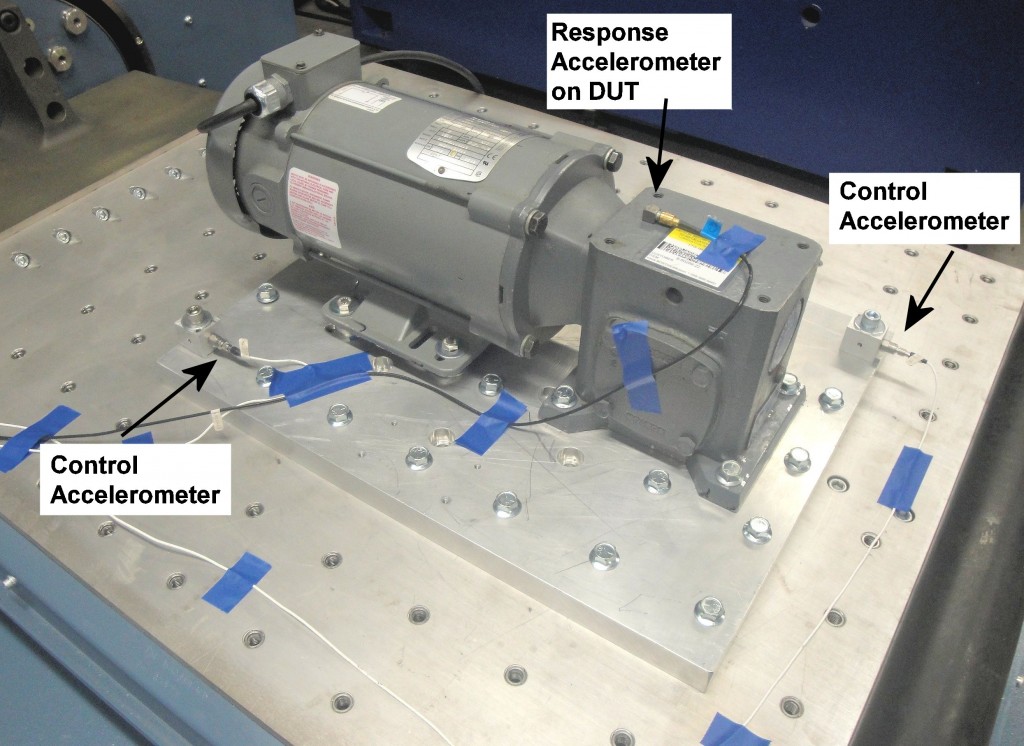
If you want or need response accelerometers, it is helpful to specify this up front. While installing response accelerometers on the DUT is typically not a big task (however it can be!), there may be some cost added for this effort. It does take extra time to install response accelerometers, take pictures for documentation in the report, setup extra data acquisition channels and process a resonance search plot for inclusion in a test report, Figure 4.
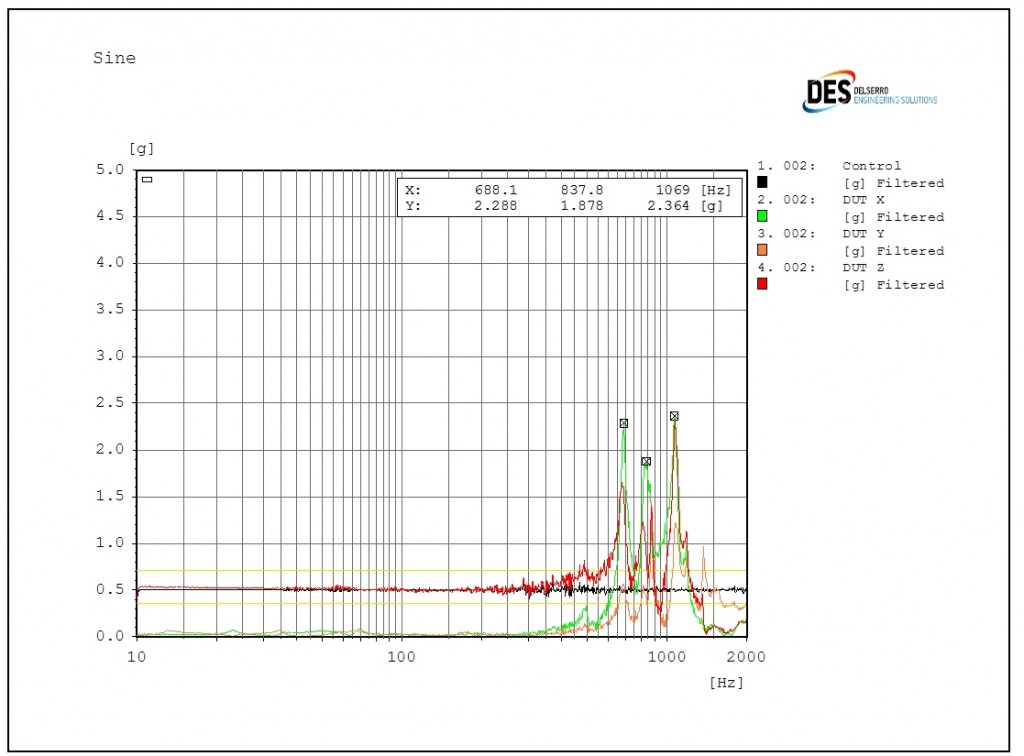
- Are combined environments (such as temperature) and vibration required?
Obviously vibration testing in combined environments is much harder and will be more costly than testing at room temperature. For now, let’s consider combined temperature and vibration testing. First, there is some time and effort involved in setting up the chamber over the shaker, Figure 5. While it varies from lab to lab, the vibration table will be inside the chamber or the table will be flush with the floor of the chamber. The chamber will be fixed. There will be space between the chamber and the vibration table. A rubber membrane will be used to seal the chamber to the vibration table. The vibrations will occur inside the chamber in a confined workspace.
Many chambers only fit over the shaker when it is oriented vertically and do not fit over a horizontal slip table. If that is the case, then different types of fixtures are required since testing in 3 axes requires rotating the fixtures, not moving the fixtures from a vertically mounted table to a horizontal slip table, Figure 6.
Also, special charge mode accelerometers are needed for working in extreme temperature environments because standard accelerometers will drift under these conditions. Accelerometers should be mechanically mounted because many adhesives do not stand up to extreme temperatures.
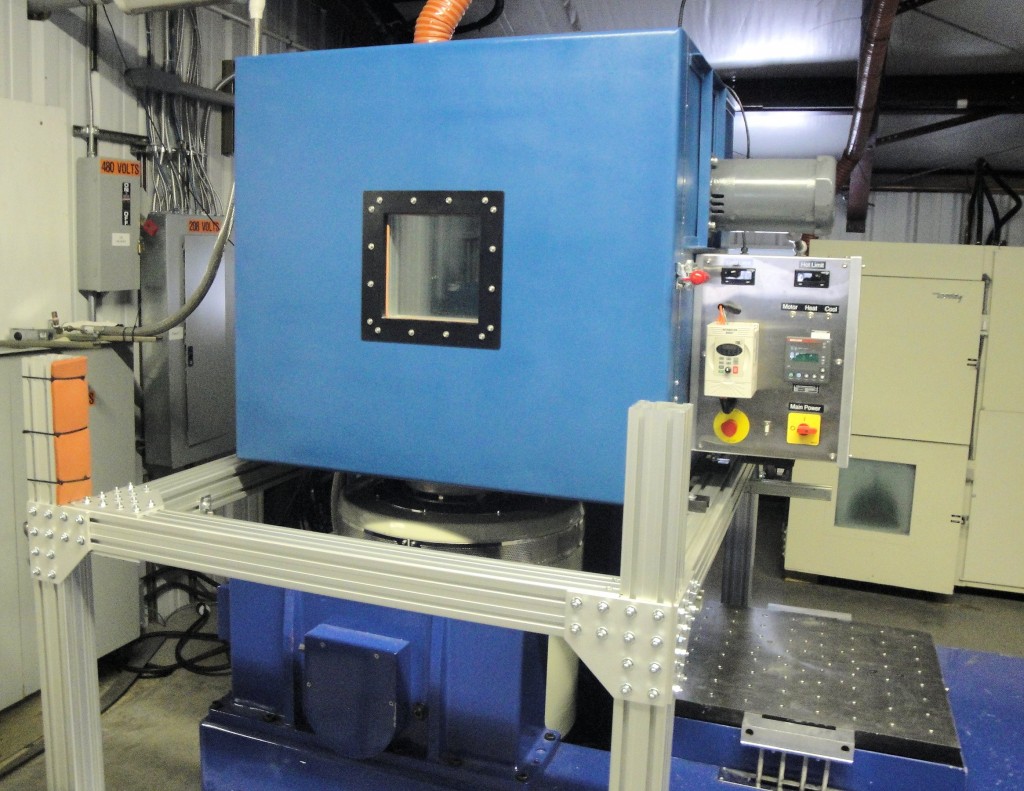
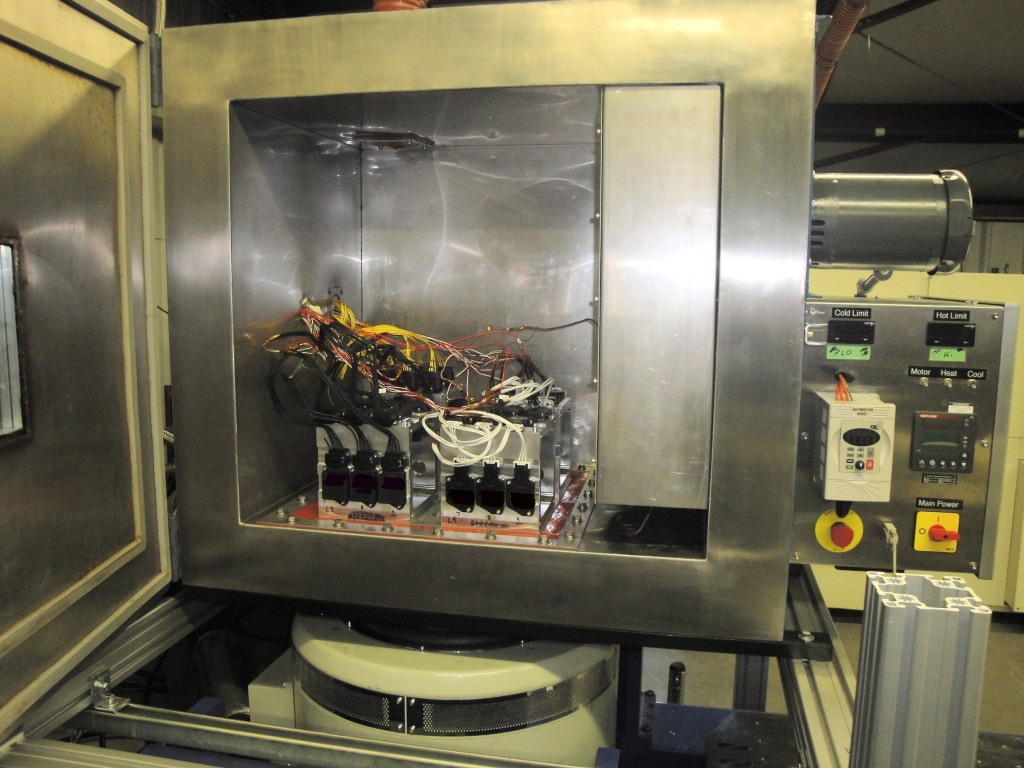
- Are any other unique requirements needed for the vibration test?
Unique requirements can be very challenging. Unique requirements could be mechanical loading, internal pressure, fluid flow, etc. For mechanical loading, it is preferred to use a spring or bolt mechanism to apply a steady load to keep weight to a minimum. DES has also performed vibration tests with internal pressure applied to products and fluid flowing through heat exchanger products. Adding extra weight to vibration tests can demand much more force from the shaker. Testing with fluids may cause sloshing and extra risk of spillage onto expensive shakers.
Vibration test labs are more than happy to help you with your vibration test requirements. But please do understand that some effort is needed on your part to define your vibration test requirements. Good communications is essential for a positive experience. DES looks forward to hearing from you!
This article is a very comprehensive and well thought out guide for anyone considering vibration testing for their products. When you are starting out in the work of qualifying products, it is helpful to have an article like this to refer to so that you can really think about what you actually require. The pictures in the article really help with visualising what a test lab will ask you about when obtaining a quote, which if you haven’t read an article like this, you wouldn’t necessarily know what they are talking about. Great job!
I know that depending on the industry, it can be very important to have a device tested for vibrations. I know that this can be especially important for drilling equipment and machinery. As you mentioned, the mass of a device can significantly influence the forces that components will experience as well as the table size and power that will be needed to perform vibration tests. Thanks for your excellent article explaining the basics about vibration testing.